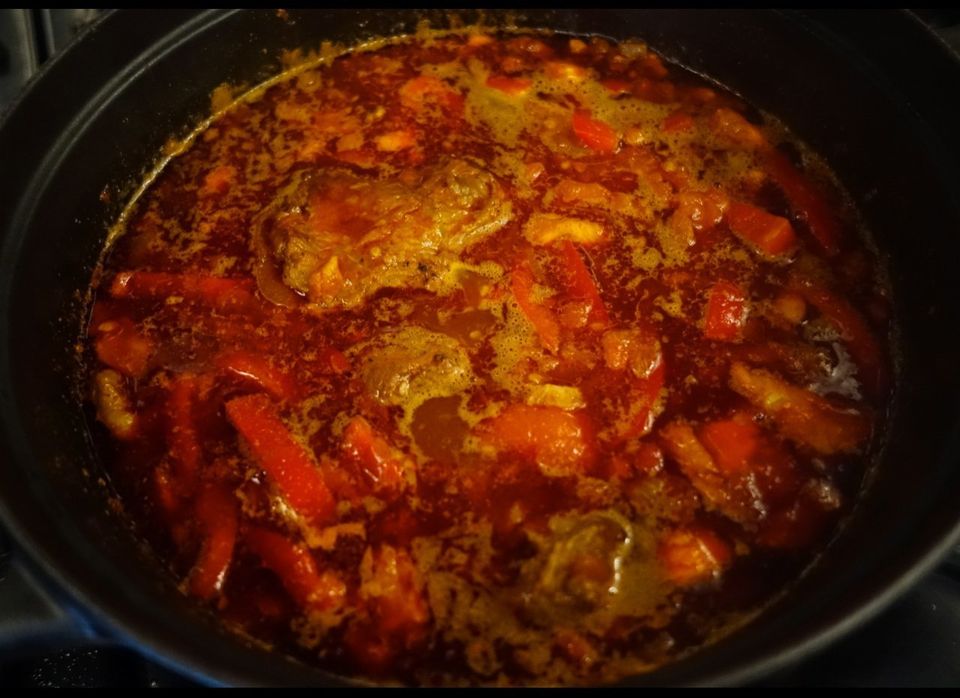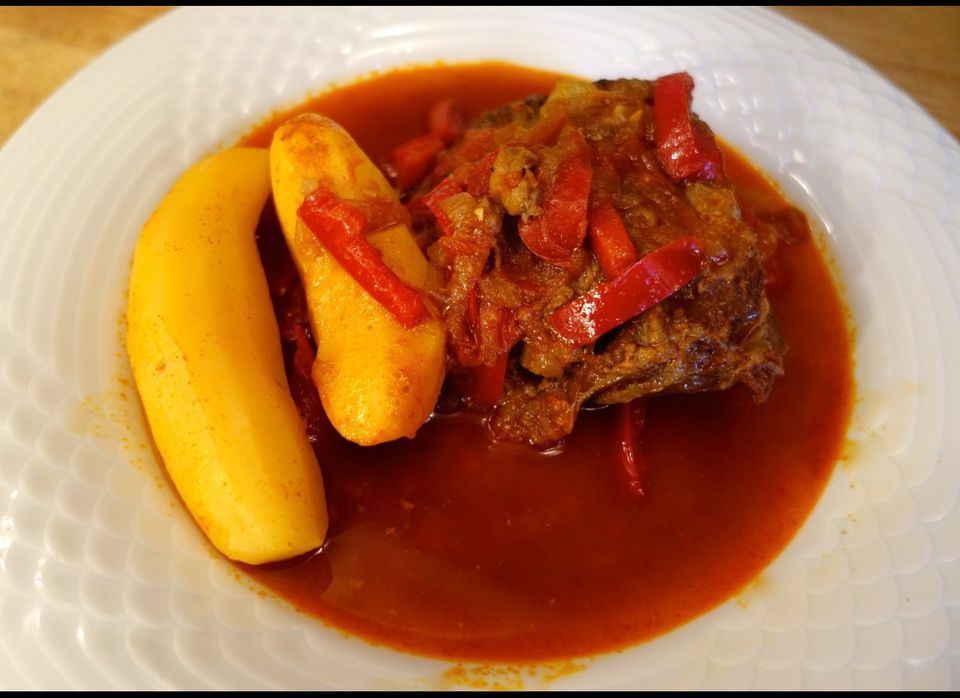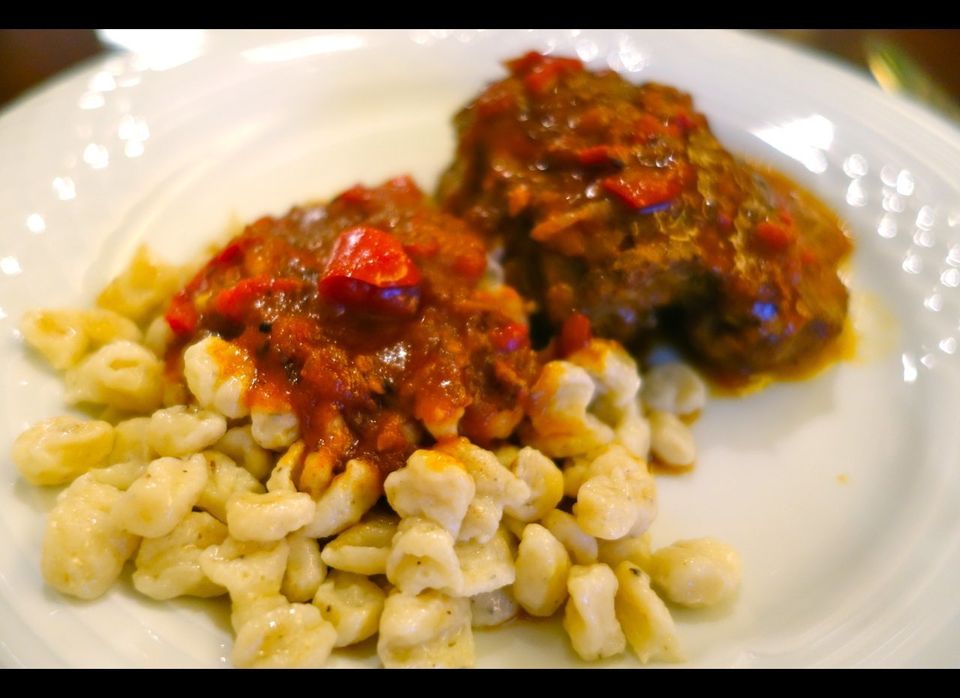I've been on the disabled list with the back pain I mentioned last week, so Jackie went to Saturday's Union Square farmers' market on her own. And what did she come back with but half a dozen veal cheeks from Tonjes Farm up in Sullivan County, New York. (Buying veal from a dairy producer is a salutary reminder that without calves or lambs or kids there is no milk.) The cheek - whether veal, beef or pork - is a uniquely fine-textured braising cut that is underappreciated by home cooks in the US, though it is not unknown in European butcher shops and supermarkets. We buy them whenever we see them - the previous haul had been of pig cheeks, from Manhattan's Eataly, several months ago.
The timing was good: The weather is just beginning to turn somewhat autumnal, and a braise would anticipate the end of summer. I say "anticipate" because, of course, the market is still full of ripe summer produce, and also in Jackie's market bag were juicy tomatoes and aromatic red bell peppers, which I knew would end up in the pan with the meat. The question was how. Some sort of Italianate or southern French-type set of flavors would have been good - there was also a fragrant bunch of thyme - but we'd had something akin to ratatouille the night before, with bread and butter. (I added fennel seed, which worked extremely well - try it next ratatouille.)
I didn't need to spend much time contemplating those vivid red ingredients before deciding that even more redness was called for, in the form of paprika. So I reached for George Lang's exemplary Cuisine of Hungary (out of print, but copies are kicking around on the Web) and turned to the chapter on stews. The most obvious choice, gulyás (i.e. goulash), was also the one that would make best use of my peppers and tomatoes. Plus, Lang's recipe calls for caraway seeds and garlic, both of which I was going to include even if it meant being inauthentic. All right, I was going to be inauthentic anyway, but at least my ingredients list wouldn't stray too far from tradition.
In fact there's so much inauthenticity here that I'm not going to highlight each instance; the outcome was delicious - and tasted at least Austro-Hungarian if not pure Magyar.
In a casserole large enough to hold the cheeks in one layer, over medium heat, I browned the well-seasoned meat in duck fat (I'd have used good lard if I'd had any, or neutral oil if I'd had neither). I did not remove the silverskin before cooking, as a cook in a fancy restaurant would have: this grows tender along with the meat. When it was lightly browned, I passed the baton to Jackie: my back was killing me and I slunk off to bed. She removed the meat from the pan and added two medium onions, sliced, and cooked them until translucent but not browned, at which point she returned the cheeks to the pan along with the accumulated juices. She smashed and finely chopped a big clove of garlic (two smaller ones would have been fine) and stirred it into the meat along with a good half teaspoon of caraway seeds and 3 level tablespoons of sweet Hungarian paprika plus a scant teaspoon of hotter paprika, also Hungarian. And salt, while bearing in mind that the meat had been salted before browning.
When the meat and onions were well coated with the spices, Jackie added a cup of stock (using stock is so inauthentic that I must alert you to my transgression) then water to generously cover the meat. When it came to the simmer, she dropped the heat to very low and covered the pan. (It could also have gone into the oven at, say 325 degrees F / 165 C.) After an hour and a quarter, I hobbled into the kitchen and added a big ripe tomato that Jackie had peeled and diced, and a big red bell pepper she'd cut into strips, and we both tasted for seasoning, including for paprika and caraway; more of the latter was needed.
This continued to cook for another 45 minutes, when the cheeks were quite tender but still needed more time to be super-soft, as cheeks ought to be. The sauce was copious: traditional goulash is usually soup-like, but I prefer my version to have a slightly denser, richer gravy. So we let it cook, uncovered, for 20 minutes longer, by which time the veal was nearly fork tender and the sauce somewhat reduced and full of flavor. We added just enough fingerling potatoes for the first night's dinner and continued to simmer for another 20 minutes. (Cubes of regular potatoes would be fine, and more traditional; I added only enough for one meal because I prefer not to let potatoes hang around in a stew and get mushy on repeated heatings-up)
I turned off the heat and after a while skimmed off some, but not all, of the fat. At dinner time, I reheated the goulash, potatoes and all. When we get to the leftovers - very soon - the plan is to reduce the sauce a little further, and to serve the dish with spaetzle. I can hardly wait.
For all the paprika and other flavors, and for all the depth of the sauce, this is not an aggressively seasoned stew, which is perfect for delicate meat like veal cheeks (or veal shoulder, which would be a good alternative). And perfect for a summer-into-autumn dinner, too.


